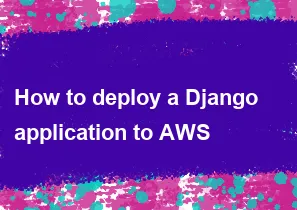How to deploy a Django application to AWS

Deploying a Django application to AWS involves several steps, including setting up an EC2 instance, configuring a database, and managing static files. Here's a general guide to help you get started:
1. Create an AWS Account:
If you don't have an AWS account, sign up for one at AWS Console.
2. Launch an EC2 Instance:
- Go to the EC2 Dashboard.
- Click on "Launch Instance" and choose an Amazon Machine Image (AMI) with your preferred operating system.
- Choose an instance type, configure instance details, add storage, and configure security groups.
3. Connect to Your EC2 Instance:
- Use SSH to connect to your EC2 instance.bash
ssh -i your-key.pem ec2-user@your-instance-ip
4. Update System Packages:
bashsudo yum update -y
5. Install Required Software:
- Install Python, pip, and other dependencies.bash
sudo yum install python3 python3-pip
6. Clone Your Django Project:
- Clone your Django project from a version control system or copy it manually to the server.
7. Install Project Dependencies:
- Navigate to your project directory and install the required packages.bash
pip3 install -r requirements.txt
8. Configure Database:
- Set up your database. If you're using AWS RDS, configure your
settings.pyaccordingly.
9. Collect Static Files:
- Run the following command to collect static files.bash
python3 manage.py collectstatic
10. Configure Web Server (Optional):
- Install a web server like Nginx or Apache to serve your Django application.
- Configure the web server to forward requests to your Django application using WSGI.
11. Set Environment Variables:
- Set any necessary environment variables, especially sensitive information like
SECRET_KEYor database credentials.
12. Run Django Application:
- Run your Django application using a process manager like Gunicorn.bash
gunicorn your_project.wsgi:application
13. Use a Process Manager (Optional):
- Consider using a process manager like
systemdorsupervisordto keep your application running.
14. Configure Domain and SSL (Optional):
- Set up a domain for your application and configure SSL using services like AWS Route 53 and ACM.
15. Monitor and Scale (Optional):
- Set up monitoring tools, and consider auto-scaling options based on your application's needs.
16. Back Up Your Data:
- Regularly back up your database and other critical data.
Remember to replace placeholder values (like your-key.pem, your-instance-ip, and your_project) with your actual values. Additionally, AWS offers various services that might better suit your needs, such as Elastic Beanstalk or ECS, depending on your deployment preferences.
Always refer to the latest AWS and Django documentation for the most up-to-date information.
-
Popular Post
- How to optimize for Google's About This Result feature for local businesses
- How to implement multi-language support in an Express.js application
- How to handle and optimize for changes in mobile search behavior
- How to handle CORS in a Node.js application
- How to use Vue.js with a UI framework (e.g., Vuetify, Element UI)
- How to configure Laravel Telescope for monitoring and profiling API requests
- How to create a command-line tool using the Commander.js library in Node.js
- How to implement code splitting in a React.js application
- How to use the AWS SDK for Node.js to interact with various AWS services
- How to use the Node.js Stream API for efficient data processing
- How to implement a cookie parser middleware in Node.js
- How to implement WebSockets for real-time communication in React
-
Latest Post
- How to implement a dynamic form with dynamic field styling based on user input in Next.js
- How to create a custom hook for handling user interactions with the browser's device motion in Next.js
- How to create a custom hook for handling user interactions with the browser's battery status in Next.js
- How to implement a dynamic form with dynamic field visibility based on user input in Next.js
- How to implement a dynamic form with real-time collaboration features in Next.js
- How to create a custom hook for handling user interactions with the browser's media devices in Next.js
- How to use the useSWRInfinite hook for paginating data with a custom loading indicator in Next.js
- How to create a custom hook for handling user interactions with the browser's network status in Next.js
- How to create a custom hook for handling user interactions with the browser's location in Next.js
- How to implement a dynamic form with multi-language support in Next.js
- How to create a custom hook for handling user interactions with the browser's ambient light sensor in Next.js
- How to use the useHover hook for creating interactive image zoom effects in Next.js